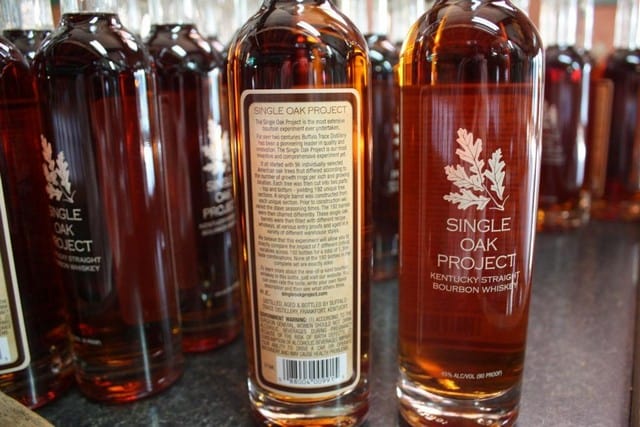When we last had looked in on the Buffalo Trace Single Oak Project, which brought together collaboration between the distillery and drinkers on creating the ultimate bourbon, all eyes were on the last round of test bottlings that were part of a much larger undertaking showcasing how different aspects of individually selected American oak trees interact with different bourbons. Now, in part with help from an esteemed group of whiskey panelists, the bourbon has been chosen which will ultimately represent the Single Oak Project whiskey which will someday be in retail.
Barrel #80, according to Buffalo Trace, was the winner out of 192 different bottlings released incrementally over the last few years. This bourbon, having been aged years, was a high rye recipe style expression, having “entered into a barrel made from oak harvested from the bottom half of the tree with staves seasoned for 12 months. The grain size of the wood was considered average and the barrel received a number four char inside. The whiskey entered the barrel at 125 proof and was aged in a concrete floor warehouse.”

To get at this being the winner, the distillery worked through feedback from some 5,645 bourbon drinkers, who in total submitted 5,086 unique whiskey reviews. This means, on average, that each of the 192 bourbons were evaluated around 26 times. Next, the top five finalists were put before the panel of bourbon judges to make the final selection through a further tasting and voting process.
This panel, besides Buffalo Trace distiller Harlen Wheatley, included the likes of WhiskyCast’s Mark Gillespie, Liza Weisstuch, Chuck Cowdery, Whisky Advocate’s Lew Bryson and Gaz Regan, among others. What they recommended in Barrel #80 is now heading into larger scale production, with the caveat you won’t be able to purchase a bottle for at least a few years.
Chose top #bourbon w/esteemed colleagues @lewbryson @boozecolumnist @christophernull #SingleOakProject @BuffaloTrace pic.twitter.com/lZQIVSZJCk
— Liza Weisstuch (@livingtheproof) June 6, 2015
Why, do you ask, must we wait so long? Again, according to Buffalo Trace,
the oak must be harvested, staves dried for 12 months, and then the bourbon must be aged for eight years. Mark your calendars for the year 2025!
Now, besides the winning bourbon being a new premium offering for the distillery, they also learned a lot on bourbon in general from all the data collected during the Project. For example, it was noted, “bourbons that produced the best aroma were made with a wheat recipe, entered at 105 proof, and aged in barrels whose staves seasoned for six months, in wood made from the bottom half of the tree.
“If flavor is your most important factor when picking a bourbon, then the research shows barrels made from the bottom half of the tree were a safer bet. And for those looking for the smoothest finish, a bourbon aged in barrels from (again!) the bottom half of the tree, but with a number three char and 9 tree growth rings per inch scored the highest.”
“The knowledge gained from conducting this research experiment is priceless,” said Mark Brown, president and chief executive officer of Buffalo Trace Distillery, in a statement. “We can now compare and confirm how each of these variables in the bourbon making process affects the finished product, which will only refine our experimental program and help us create even better whiskeys in the future.”









